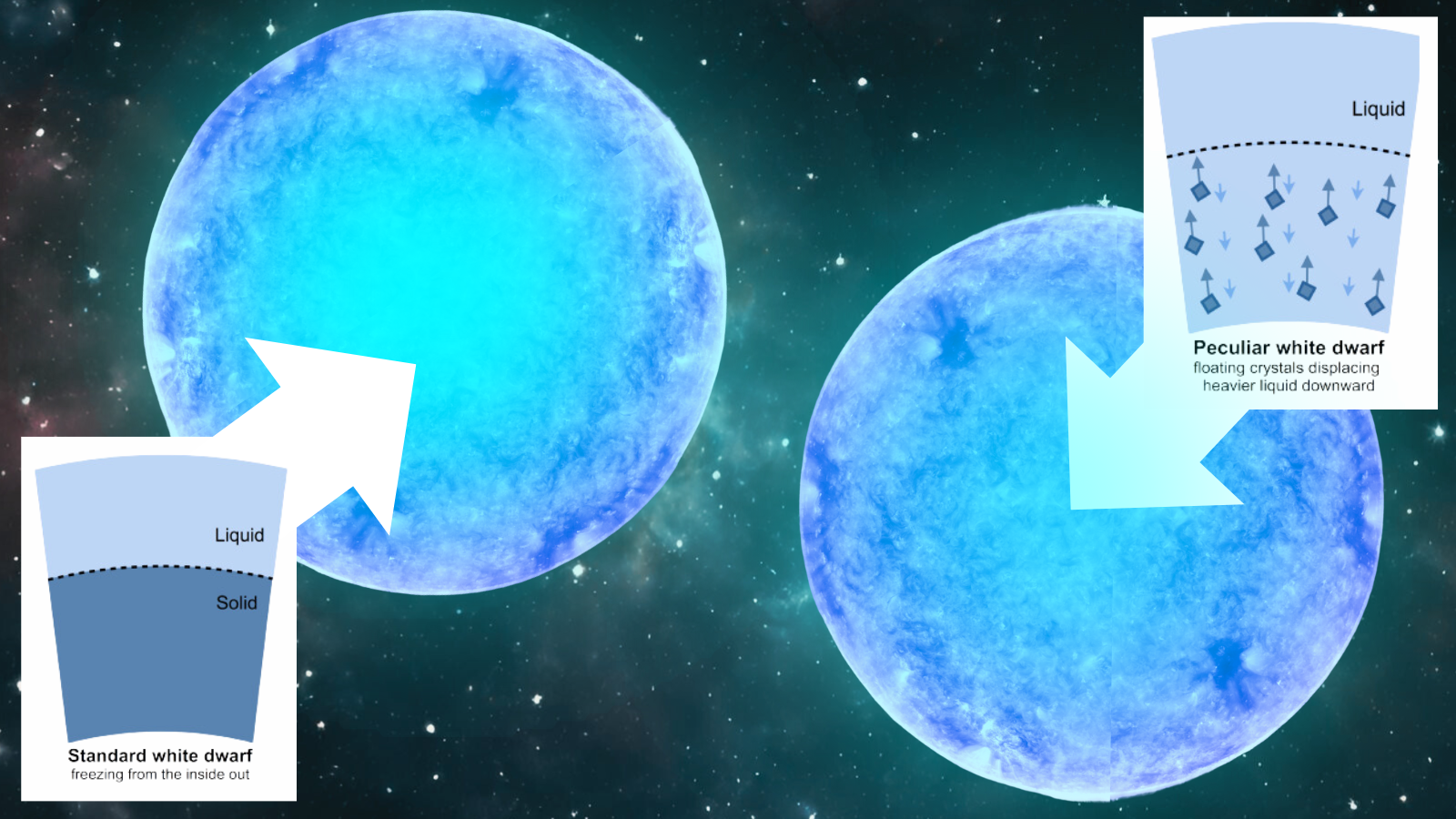Some 'dead' stars hide celestial fountains of youth beneath their surfaces

White dwarfs are the stars that will be left behind when stars like the sun "die," smoldering away in space as cooling stellar embers.
Recent observations indicated that some of these stellar corpses may actually take longer to cool off than previously expected. This means that white dwarfs may have a way of generating energy after their "deaths," defying the classical picture of them being inert dead stars. As a result, some white dwarfs could actually be billions of years older than currently estimated.
Analyzing data from the Gaia space mission in 2019, scientists discovered a population of white dwarfs that seem to have stopped cooling for billions of years. Now, a team of researchers led by Antoine Bédard from the University of Warwick and Simon Blouin from the University of Victoria think they know what mechanism lies behind this baffling discovery.
Related: For this dead star, 72 years is a single Earth day
The fountain of stellar youth
White dwarfs are born when stars that possess around the same mass as the sun exhaust the fuel supply necessary for nuclear fusion at their cores. This supply is made up of the universe's lightest element: Hydrogen. The end of fusion, aka the conversion of hydrogen to helium, in the stellar core also cuts off the energy that has pushed outwards and protected the star from collapsing under its own gravity for often billions of years.
Crushed by gravity, the outer layers of the star where nuclear fusion is still happening are ripped away. These layers "puff out" to tens, or even hundreds, of times the original radius of the star during what is known as the red giant phase of the star's life. Eventually, these surrounding layers disperse, leaving the cooling, exhausted stellar core behind as a white dwarf.
For the sun, this transformation will begin in around 5 billion years; the red giant phase of our star will see it swell out to the radius of Mars. During this time, the sun will end up swallowing the inner planets, including Earth. 97% of the stars in the Milky Way will undergo the same basic process to become white dwarfs.
Breaking space news, the latest updates on rocket launches, skywatching events and more!
Scientists had previously considered that white dwarfs with depleted nuclear fuel represent the nearly inert, final stages of smaller stars. It has been theorized that within their hearts, plasma that had once been broiling and turbulent stellar matter freezes solid as heat is no longer produced. This would result in white dwarfs solidifying from the inside out over the course of billions of years.
Bédard and colleagues think that, for some white dwarfs, the dense plasma within doesn't freeze from inside to outside. They have discovered a celestial fountain of youth, so to speak, which lurks beneath some of these stars' shells.
Within these age-defying white dwarfs, solid crystals are created as the dead star cools — crystals that can float upon denser liquid.
As this solid matter floats upwards, the team says it displaces liquid material that moves downwards. The transport of heavier material toward the hearts of these white dwarfs releases gravitational energy. This energy this can be converted to heat, thereby halting the cooling process for billions of years.
"This explanation matches all the observational properties of the unusual white dwarf population," Bédard said in a statement. "This is the first time this transport mechanism has been observed in any type of star, which is exciting: it’s not every day we uncover a whole new astrophysical phenomenon!"
One of the big questions raised by the discovery of white dwarfs halting their cooling processes is what makes them different from their "deader" counterparts, per se. Those are the white dwarfs the cool just as expected.
"The difference is likely due to the composition of the star," Blouin explained. "Some white dwarf stars are formed by the merger of two different stars. When these stars collide to form the white dwarf, it changes the composition of the star in a way that can allow the formation of floating crystals."
Currently, when scientists look at white dwarfs, they assume the cooler one is, the more ancient it is. The cooling delay experienced by these peculiar white dwarfs, however, could mean they have temperatures that make them appear much younger than they actually are.
Thus, the discovery of these age-defying white dwarfs and the mechanism they use as a "fountain of youth" may actually redefine the way that astronomers date stars in general.
"The transport mechanism we have uncovered means that some white dwarfs have been shining as bright as ‘normal’ stars for billions of years," Bédard said. "This complicates age-dating and our use of white dwarfs to reconstruct the formation of our galaxy."
The team's research was published on March 6 in the journal Nature.

Robert Lea is a science journalist in the U.K. whose articles have been published in Physics World, New Scientist, Astronomy Magazine, All About Space, Newsweek and ZME Science. He also writes about science communication for Elsevier and the European Journal of Physics. Rob holds a bachelor of science degree in physics and astronomy from the U.K.’s Open University. Follow him on Twitter @sciencef1rst.

